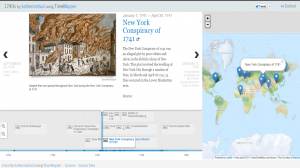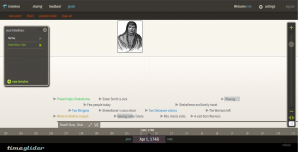When learning history and trying to understand it, it tends to not make sense when dates are scrambled and out of order. The story that it tells becomes distorted between what is happening and what has already happened. Although different in several ways, Timemapper and Timeglider are similar in the fact that they put events in order by dates and when they happened. As Grafton points out, we use chronologies all of the time and we could not do without them. Timemapper and Timeglider both provide an array of events that are ordered by date. They both also display a visual aspect to them that can be incorporated into the timeline of events.
As previously mentioned, Timemapper and Timeglider are different in several ways. Timemapper is not as magnified. In return, its visual aspect is not just a picture to go along with the event, but also a map of the location of the events. These are displayed through the geographical locations of where events took place. Grafton discusses how a timeline is a much more “complex” and “colorful” figure than is usually thought. Timemapper is a great example for this in that it provides you with the map of where certain events in the timeline took place.

In contrast, Timeglider is, or more so can be, much more magnified. Depending on the spread of time from the historical events that are being included in the Timeglider timeline, the display can be zoomed into as far as the hour on a certain day. This was convenient in our Powell Diary entries because there were several events happening within days of each other and zooming in allowed us to see the separation in them.

Grafton goes into detail about how the development of the timeline has continued to raise more and more questions. This is understandable due to how advanced they have become. It is impeccable to think that timelines went from be just that, times on a line, to being detailed events with visual representations through both pictures and maps.